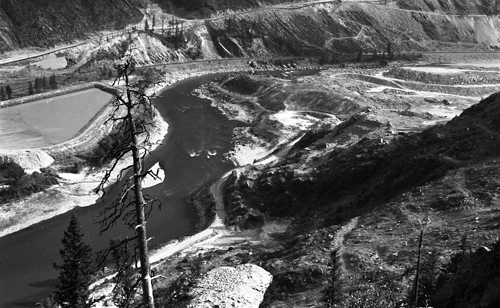

The Libby Dam under construction in 1969.
The Kootenay River begins in the Rocky Mountains in Southeastern British Columbia east of Canal Flats. The river then flows south, passing the headwater of the Columbia River at Columbia Lake at Canal Flats and enters the United States into Montana. The river then moves west and North through Montana and Idaho reentering Canada south of Creston. At this point the river forms Kootenay Lake, which runs North and South, then flows west forming the West Arm of Kootenay Lake as far as the City of Nelson. The water continues to flow westward as the Kootenay River until Castlegar where it flows into the Columbia River. After leaving British Columbia it moves south and finally west again to the Pacific Ocean through Washington and Oregon States.
The Libby Dam, which was constructed by the US Army Corps of Engineers, was built under the Columbia River Treaty to control the flood waters of the Kootenay River and provide hydroelectricity to the Bonneville Power Administration (BPA) in the United States. Construction of the dam began in 1966 with the first power generated from it in 1975.
The building of the Libby Dam created the reservoir known as Koocanusa (named for KOOtenay, CANada and USA) that extends northward 140 km with 68 km in British Columbia.
In Montana, prior to the flooding, the town of Rexford was moved to higher ground, where a new school, water system, sewage system, fire station, post office and road were built. The State Highway 37 was also relocated to higher ground on the east side of the reservoir. In British Columbia the settlements of Waldo and Wardner were either relocated or abandoned. The railway and highway were both relocated to avoid the flooded areas and bridges. Homes and other buildings were removed prior to the flooding.
Lake Koocanusa holds 13 percent of the total water stored in the Columbia River system. The value of this water is multiplied because it is used to produce power sixteen times before it reaches the Pacific Ocean.